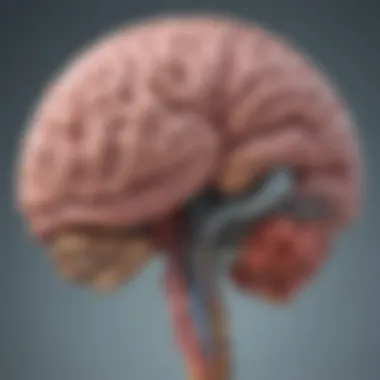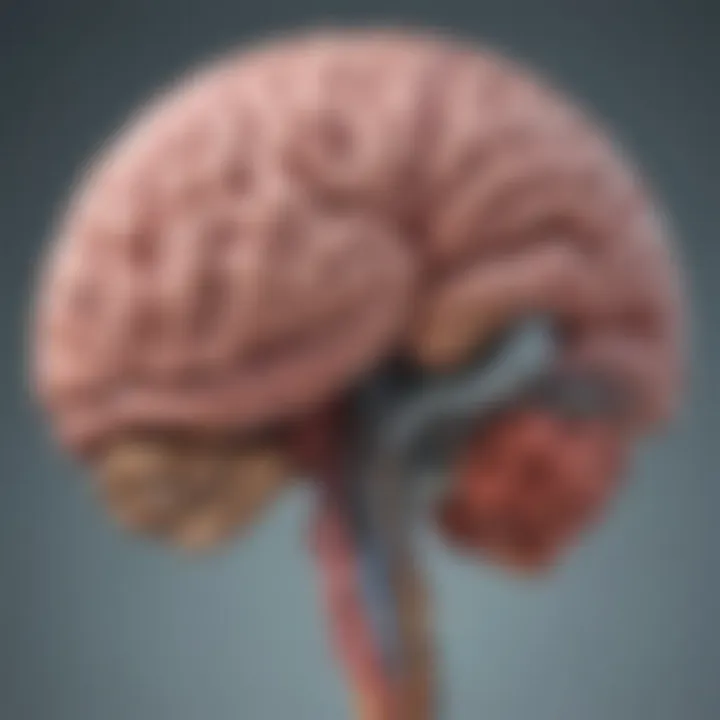Exploring Human Brain Diseases: Causes and Treatments


Intro
The human brain is an astonishingly intricate organ. It not only regulates basic bodily functions but also underpins our thoughts, emotions, and actions. With the ever-growing population experiencing various brain diseases, understanding these conditions becomes increasingly urgent. In this article, we’ll delve deep into the myriad of brain disorders that affect individuals worldwide. From neurodegenerative diseases such as Alzheimer’s and Parkinson’s to neuroinflammatory conditions like multiple sclerosis, an exploration into these afflictions reveals invaluable insights into their etiology, symptoms, and treatment modalities.
Arming ourselves with this knowledge can help those battling these diseases and enlighten caregivers and professional healthcare providers. The significance of advancing research should not be overlooked. This article aims to shed light on the overlaps in neuroscience and technology, aiding in the application of innovative therapeutic strategies.
Research Overview
Methodological Approaches
The exploration of human brain diseases involves a cornucopia of research methodologies. These can range from clinical studies that gather data on patient symptoms and responses to treatments, to laboratory experiments that dissect the mechanics at the cellular and molecular levels. Researchers often employ clinical trials for testing new drugs, while epidemiological studies help understand the prevalence and risk factors associated with various brain diseases.
A noteworthy approach includes meta-analyses. These vigorous assessments pool data from numerous studies, providing significant insights into patterns that might not be visible in individual trials. For instance, capitalizing on advanced imaging techniques, like functional MRI, has enabled researchers to visualize brain alterations in real time, bringing a richer understanding of neurodegenerative processes.
Significance and Implications
Understanding the underlying mechanisms of brain diseases can have profound implications. Knowledge of how certain genes predispose individuals to these conditions may pave the way for targeted interventions. Furthermore, recognizing the social and environmental factors that contribute to these diseases can inform public health strategies.
The intersection of neuroscience research and societal needs is crucial in combating brain diseases, reminding us that every piece of information gleaned could lead to life-altering treatments.
Current Trends in Science
Innovative Techniques and Tools
Recent trends in research have encouraged the adoption of innovative techniques and tools. The development of CRISPR technology, for instance, has opened up exciting possibilities in genetic therapies. Researchers can now manipulate genes in a more precise manner, potentially correcting mutations responsible for certain brain diseases.
Advancements in biomarker discovery also play a critical role. By identifying specific proteins or other molecules in the blood or cerebrospinal fluid, clinicians can diagnose diseases much earlier than ever before. This early detection can drastically change prognosis and treatment effectiveness.
Interdisciplinary Connections
A growing emphasis on interdisciplinary approaches has made a mark in the understanding of brain diseases. Collaborations between neuroscientists, geneticists, and data scientists are becoming increasingly popular. For instance, machine learning algorithms are now used to predict the onset of conditions by analyzing vast sets of patient data. This integration of diverse fields enriches our understanding and response to complex health issues.
In sum, the realms of neuroscience and technology are evolving hand in hand, providing promising avenues for better diagnosis and intervention strategies in tackling brain diseases. By staying updated with the latest advancements, professionals in the field can translate findings into practical applications, ultimately enhancing patient care and outcomes.
Prelude to Human Brain Diseases
Human brain diseases encompass a wide range of conditions that affect the structure and function of the brain. Understanding these diseases is crucial, not just for medical professionals, but also for individuals navigating their own health—be it patients, caregivers, or simply the curious minds looking to enhance their knowledge.
The brain, being the command center of human behavior and cognition, merits attention for several reasons. Firstly, brain diseases can have profound implications on one’s quality of life. Take Alzheimer's disease, for instance. Its slow encroachment can strip away memories and identities, leaving a profound impact on patients and their loved ones alike.
Moreover, the realm of brain diseases is not limited to age-related conditions. Neurodevelopmental disorders such as Autism Spectrum Disorder thrust forward a new set of challenges, affecting individuals from early childhood through adulthood. Recognizing these diverse aspects is important as it lays the groundwork for empathy and a better understanding of what affected individuals endure.
In this exploration, we will delve into how these diseases are classified, their symptoms, diagnostic practices, and emerging treatment options. The classification itself is enlightening; it sheds light on how certain disorders are similar in nature yet fundamentally different. For example, differentiating between neurodegenerative diseases and neuroinflammatory disorders reveals the underlying mechanisms at play.
Key Points to Consider
- The intricacies of each disease vary significantly, necessitating a tailored approach to treatment and care.
- Ongoing research aims to not just treat but also anticipate these diseases, opening pathways for preventative measures.
- The psychosocial ramifications of brain diseases highlight the need for holistic treatment approaches that address both physiological and emotional well-being.
"Understanding brain diseases is a gateway to unlocking not only treatment options but also fostering compassion and support for those affected."
Finally, increasing awareness about brain diseases among the general public can lead to early detection and intervention, significantly improving outcomes. With this comprehensive exploration, we aim to demystify brain diseases and shed light on the vital importance of continued research and understanding in this field.
Classification of Brain Diseases
Understanding the classification of brain diseases is fundamental as it provides a structured way to explore the complexities of various conditions that affect the human brain. This division into different categories allows clinicians, researchers, and the general public to grasp the causes, symptoms, and potential interventions associated with these diseases. By effectively classifying brain diseases into neurodegenerative diseases, neuroinflammatory disorders, cerebrovascular disorders, traumatic brain injuries, and neurodevelopmental disorders, we can work toward tailored treatments and proactive healthcare strategies.
Additionally, it highlights the diversity within neurological conditions, opening avenues for focused research and increased awareness. Recognizing how each class of disorders contributes to the broader understanding of brain health helps illicit better preventive measures and treatment options.
Neurodegenerative Diseases
Neurodegenerative diseases represent a category of brain diseases characterized by the progressive degeneration of the structure and function of the nervous system. They are often related to age and can lead to significant disability, impacting the quality of life.
Alzheimer's Disease
Alzheimer's disease is perhaps one of the most widely recognized neurodegenerative diseases, with its hallmark symptoms of memory loss and cognitive decline. This condition affects millions globally and is a leading cause of dementia. One of the most glaring characteristics of Alzheimer's is the accumulation of amyloid plaques and tau tangles in the brain, which is believed to contribute to the death of neurons. The focus on this disease is crucial because it sheds light on the importance of early detection and intervention strategies. A unique aspect of Alzheimer's is the genetic predisposition seen in some patients, making it a critical area for research on prevention.
However, there are some advantages to acknowledging the social implications of this disease. Discussing Alzheimer's encourages conversations about caregiving and community support systems that are necessary for patients and their families.
Parkinson's Disease
Parkinson's disease is another significant neurodegenerative condition, primarily affecting motor function due to the loss of dopamine-producing neurons. The tremors, stiffness, and bradykinesia (slowness of movement) that characterize Parkinson's can drastically affect a person’s daily life. The key aspect here is the impact on motor skills and coordination. It's a prevalent choice for discussion in this article as it serves to emphasize the intersection between neurological health and psychological well-being.
One unique feature of Parkinson's is the variability in symptoms among patients, which raises questions about individualized treatment plans. These differences highlight the complex nature of brain diseases and remind us that a one-size-fits-all approach may not be sufficient.
Huntington's Disease
Huntington's disease brings a different dimension to the conversation about neurodegeneration. This genetic disorder arises from a mutation in the HTT gene, leading to progressive motor dysfunction and cognitive decline. The key characteristic is the clear hereditary pattern and its impact on family health dynamics, making it a significant subject in discussions about genetic counseling and familial support.
In this article, discussing Huntington's also sheds light on the ethical implications related to testing for the disease. While it could provide an advantage in planning and intervention, it also raises emotional and psychological burdens on those at risk.
Neuroinflammatory Disorders
Neuroinflammatory disorders encompass a variety of conditions characterized by inflammation in the nervous system, affecting brain function and overall health. The exploration of these conditions is vital as they often intersect with autoimmune issues and can have broad repercussions on neurological health.
Multiple Sclerosis
Multiple sclerosis is one of the most prevalent neuroinflammatory disorders, resulting in a range of symptoms due to the degeneration of the protective myelin sheath covering nerve fibers. A significant aspect of Multiple Sclerosis is its unpredictable nature, where symptoms can vary greatly between individuals, leading to considerable challenges in daily functioning. Understanding this disorder is beneficial for this article as it showcases the complex relationship between the immune system and neurological health. Its unique feature lies in the episodic flare-ups that can drastically affect an individual's capabilities, necessitating a multidisciplinary approach to treatment.
Encephalitis
Encephalitis refers to the inflammation of the brain itself and can stem from various origins, including viral infections. It can rapidly progress, leading to neurological deficits, making awareness and swift treatment vital.
One key characteristic to highlight here is the need for immediate medical intervention, emphasizing the importance of recognizing symptoms promptly.
This conversation is valuable for raising public awareness about preventive measures against infections that can result in this condition, such as vaccination.
Neuroinflammation and its Impact
Focusing on neuroinflammation allows for a deeper understanding of how inflammatory processes can lead to or exacerbate neurological conditions. The key aspect of this discussion lies in recognizing that inflammation isn’t merely a response but a crucial factor that can alter brain health over time. The unique advantage of discussing neuroinflammation is the potential it holds for developing novel therapies targeting this process, thus providing hope for many affected by chronic neurological conditions. This topic is also essential as it encourages a holistic view of brain health, urging integration with lifestyle choices.
Cerebrovascular Disorders


Cerebrovascular disorders include conditions that affect blood circulation in the brain, leading to severe consequences. Understanding these disorders is vital because they represent an acute category of brain disease that can develop suddenly and with significant impacts.
Stroke Types and Mechanisms
Strokes can be categorized mainly into ischemic and hemorrhagic types, each with distinct mechanisms and causes. The key feature of these conditions is the urgency of medical attention needed to mitigate damage. Focusing on stroke types provides insight into preventive strategies, as understanding risk factors can guide lifestyle choices. The unique aspect of strokes is their sudden onset, which can leave survivors with long-term neurological impairments, emphasizing the importance of rehabilitation and support.
Aneurysms
Aneurysms, the abnormal dilation of blood vessels in the brain, can be critical and dangerous. The defining characteristic is their potential to rupture, leading to hemorrhagic strokes. Discussion of this in the article is essential, as early detection and timely intervention can be lifesaving. The unique challenge presents itself in the form of surgical options, which could prevent complications but also comes with inherent risks.
Cerebral Venous Sinus Thrombosis
Cerebral venous sinus thrombosis involves the formation of a clot within the brain's venous system, leading to severe headaches and possible neurological disorders. The main aspect here is the overlooked nature of this disorder, even among healthcare professionals. Advocating awareness of this condition can help minimize the chances of misdiagnosis or delayed treatment.
The exploration of each cerebrovascular disorder highlights the need for ongoing education and prevention methodologies, being both a challenge and necessity in medical practice.
Traumatic Brain Injuries
Traumatic brain injuries result from external forces impacting the cranial contents. These injuries are an important topic to explore as they can occur at any age and from various incidents, such as falls or vehicular accidents.
Concussions
Concussions are mild forms of traumatic brain injury but can lead to significant long-term cognitive challenges when not properly managed. The key feature is their subtlety, often going unnoticed at first, posing a risk during recovery. Discussing this in the article elevates awareness of proper concussion management in sports and other activities. One unique benefit is the emphasis on preventive strategies such as proper equipment and education, necessary to protect athletes and others at risk.
Contusions
Contusions are bruises on the brain and can lead to swelling, which may require surgery in severe cases. The characteristics allow for varied approaches to treatment, ranging from observation to surgical interventions. Exploring this issue in the article underscores the need for emergency medical training to improve outcomes for patients with contusions.
Chronic Traumatic Encephalopathy
Chronic traumatic encephalopathy is a progressive disease linked to repeated head injuries, such as those seen in contact sports. The key aspect to discuss is its cumulative nature and potential long-term consequences, including cognitive decline and changes in behavior. Addressing chronic traumatic encephalopathy provides opportunities to look at policy implications in sports and promote discussions around safer practices and regulations, benefiting the audience concerned with athlete welfare.
Neurodevelopmental Disorders
Neurodevelopmental disorders arise during the developmental phase of an individual, affecting cognitive, social, and emotional abilities. These conditions are vital in discussions about health as they often require early intervention for the best results.
Autism Spectrum Disorder
Autism Spectrum Disorder presents a range of challenges in communication and social interactions. The unique characteristic of this disorder lies in its broad spectrum, reflecting diverse ways it presents among individuals. Acknowledging it in this article is essential for fostering discussions about inclusivity, as early and appropriate interventions can enhance outcomes significantly for those with autism.
Attention Deficit Hyperactivity Disorder
Attention Deficit Hyperactivity Disorder is commonly diagnosed in children and involves challenges with attention, impulsivity, and hyperactivity. Its widespread recognition makes it a relevant topic, particularly in understanding how societal factors can influence diagnosis and management. One unique feature is the evolving nature of this disorder, often persisting into adulthood. Highlighting this can spark conversations about support systems and educational strategies for both children and adults.
Cerebral Palsy
Cerebral Palsy involves motor function impairments resulting from brain damage acquired during or shortly after birth. This condition serves as a crucial topic because it emphasizes the importance of supportive therapies and rehabilitation programs.
The uniqueness lies in its lifelong impacts on motor and cognitive functions, necessitating a broad approach towards care that integrates healthcare, education, and social services.
In summary, the classification of brain diseases not only allows for effective communication and understanding among professionals but also paves the way for tailored interventions, raising awareness for preventive measures. Each category of disorders uniquely contributes to our collective understanding of brain health, rendering the importance of ongoing research and interdisciplinary cooperation.
Common Symptoms Across Brain Diseases
In addressing brain diseases, recognizing common symptoms is crucial for both diagnosis and patient care. These overarching features create a foundation for understanding different disorders, facilitating earlier detection and intervention strategies. Understanding these symptoms aids clinicians, caregivers, and patients navigate the complexities associated with varying conditions. By delving into specific symptomatic expressions, we can unravel how these manifestations connect to the underlying brain pathology.
Cognitive Impairments
Cognitive impairments stand as a central theme in many brain disorders, affecting memory, attention, and decision-making abilities. Conditions like Alzheimer's disease commonly showcase these deficits, often beginning with simple forgetfulness and escalating to significant challenges in daily functioning. For instance, a person might misplace objects or struggle to remember recent conversations. These early signs may be dismissed, but they often serve as a wake-up call for further evaluation.
The impact stretches beyond the individual; families may face emotional turmoil as they witness their loved ones change. Recognizing these cognitive shifts is imperative for timely diagnosis and management, paving the way for interventions that can help maintain quality of life.
Motor Function Disturbances
Motor function disturbances offer another vital symptom cluster among brain diseases. Disorders like Parkinson's disease may first present with subtle tremors, a slight cough in the hand or a minor imbalance. Over time, these can escalate into more severe issues such as rigidity and slowed movements. Affected individuals find everyday tasks, like buttoning a shirt or rising from a chair, increasingly challenging.
These motor disturbances not only compromise independence but also affect emotional well-being. The psychological burden can be just as significant as the physical limitations, often leading to frustration and isolation. Recognizing motor dysfunction is pivotal in neurologic assessments and forms the basis for therapeutic interventions aimed at improving mobility and functionality.
Sensory Abnormalities
Sensory abnormalities often manifest subtly but can heavily influence an individual's quality of life. For example, people with multiple sclerosis may report unusual sensations like tingling or numbness. These symptoms may fluctuate or worsen, leading to uncertainty and anxiety. Contrast this with Huntington's disease, where individuals might experience distortions in their perception of space, contributing to a lack of coordination.
These sensory changes are not merely physical anomalies; they influence how individuals interact with their surroundings. Understanding sensory abnormalities is essential for tailoring supportive therapies aimed at enhancing daily functioning and reducing sensory overload.
Emotional and Behavioral Changes
Emotional and behavioral changes can be some of the most challenging symptoms to navigate, as they often cause distress not only for the sufferer but also for family and friends. Conditions such as depression and anxiety are frequently observed in conjunction with various brain diseases, like dementia and traumatic brain injuries. A person may exhibit mood swings or shifts in their baseline personality, complicating relationships and support networks.
For instance, a once jovial individual may withdraw socially, leading to feelings of loneliness and despair. Identifying these changes can often be overlooked, causing a delay in management. Addressing emotional health through therapies and support systems becomes a crucial aspect of comprehensive care.
Understanding these common symptoms across brain diseases not only shapes the clinical approach but also fosters greater empathy and support for afflicted individuals.
By dissecting these symptomatic manifestations, healthcare providers can better understand the neurological landscape of brain diseases and better equip themselves to address the needs of their patients.
Diagnosis of Brain Diseases
The diagnosis of brain diseases plays a pivotal role in managing the complexity of neurological conditions. Identifying the nature and source of a symptom is like piecing together a jigsaw puzzle, where every detail is essential. Effective diagnosis leads to tailored treatment plans, ultimately improving patient outcomes. Among the multitude of challenges that healthcare professionals face, accurately diagnosing brain diseases can feel like searching for a needle in a haystack. What makes this process particularly crucial is the variety of disorders that can manifest similar symptoms—misdiagnosis can lead to inappropriate or even harmful treatment.
A comprehensive approach to diagnosis typically involves a plethora of methods, ranging from clinical evaluations to advanced imaging techniques. Each element serves as a building block, contributing to a clearer understanding of a patient’s condition. Furthermore, early diagnosis is not just beneficial; it can save lives. For instance, catching certain diseases early can delay progression considerably, making a strong case for why improved diagnostic methods are essential in the landscape of brain health.
Clinical Evaluations
Clinical evaluations are often the first step in the diagnostic journey. This involves a thorough assessment of a patient's medical history, along with a detailed physical and neurological examination. Physicians look for various signs that can indicate the presence of a brain disease. They may ask patients about symptoms and any changes in their behavior, memory, or motor skills.
These assessments often incorporate cognitive tests, which evaluate memory, attention, and problem-solving abilities. A neurologist may even conduct reflex tests to gauge how well a patient's nervous system is functioning. Though clinical evaluations provide significant insights, they are often just the tip of the iceberg in a comprehensive diagnostic process.
Imaging Techniques
Imaging techniques form an essential facet of brain disease diagnosis. These provide a visual representation of the brain, allowing for deeper insights that are not accessible through clinical evaluations alone.
Magnetic Resonance Imaging


Magnetic Resonance Imaging (MRI) is a prominent diagnostic tool widely used in neurology. It produces high-resolution images of the brain and spinal cord by using powerful magnets and radio waves. This feature of MRI is particularly beneficial for visualizing soft tissue, allowing for the identification of tumors, inflammation, and structural anomalies. One unique aspect of MRI is its non-invasive nature; it does not rely onX-rays, making it a safer option for patients. However, its high cost and lengthy procedure time can be considered disadvantages in some clinical settings.
Computed Tomography
Computed Tomography (CT) scans deliver a clearer picture of the brain's structure, utilizing X-rays taken from different angles. The key characteristic of CT scans lies in their rapid processing time, making them invaluable in emergency situations, such as when a stroke is suspected. The ability to detect bleeding or structural fractures in a short time frame underscores its utility. However, the exposure to radiation is a noted disadvantage when compared to MRI, so the two imaging modalities often complement one another in clinical practice.
Positron Emission Tomography
Positron Emission Tomography (PET) offers another dimension to brain analysis by measuring metabolic activity. This imaging technique involves injecting a radiotracer, which allows healthcare providers to observe how brain cells are functioning in real-time. The crucial advantage of PET is its ability to detect changes at the cellular level, often before physical symptoms manifest. However, this method is considerably more expensive than other imaging options, limiting its availability in many healthcare settings.
Biomarker Assessments
Biomarker assessments have become increasingly promising in diagnosing brain diseases. These assessments analyze biological markers—substances found in blood, cerebrospinal fluid, or brain tissue—that can indicate the presence of a disease. Biomarkers can serve as invaluable tools not only for diagnosis but also for prognosis.
Biomarker tests can be less invasive than traditional tissue biopsies and can often provide rapid results. This advantage significantly contributes to the efficiency of the diagnostic process. However, the specificity and reliability of certain biomarkers still need substantial validation, calling for further research in this domain.
Ultimately, diagnosing brain diseases is a multifaceted process requiring a blend of clinical judgment, advanced imaging, and innovative biomarker assessments. Each method enriches the diagnostic picture, allowing healthcare professionals to move towards effective treatment interventions.
Current Treatment Approaches
The landscape of treating brain diseases has undergone tremendous evolution over the years, making it a critical area of focus in this article. Understanding the various treatment options available allows patients, caregivers, and healthcare professionals to make informed decisions. Treatment approaches can be broadly categorized into three main types: pharmacological interventions, surgical options, and non-pharmacological therapies, each playing a significant role in managing different brain conditions.
Pharmacological Interventions
Pharmacological interventions are often the first line of defense against many brain diseases. These treatments primarily focus on alleviating symptoms, slowing disease progression, and addressing underlying pathologies. Many patients rely on medication to manage conditions such as Alzheimer’s and Parkinson’s disease. Medications like donepezil for Alzheimer’s may help improve cognitive function, while levodopa is a cornerstone treatment for managing motor symptoms in Parkinson’s disease.
However, it is crucial to approach these interventions thoughtfully, as side effects can vary significantly from person to person. Some may experience severe reactions, while others find specific regimens tremendously effective. Continual assessments and adjustments are key to optimizing treatment outcomes.
Surgical Options
When pharmacological solutions fall short, surgical options may provide hope. These procedures can range from minimally invasive techniques to more complex surgeries. For instance, deep brain stimulation (DBS) has emerged as a promising option for patients with treatment-resistant Parkinson’s disease. This involves implanting a device that sends electrical impulses to specific brain regions, alleviating symptoms effectively.
Surgery, however, is not without its risks and complications. Decisions must be made carefully, weighing the potential benefits against the chances of adverse outcomes. Moreover, patient education and consent are crucial throughout the decision-making process, ensuring that patients fully understand all aspects of the surgery.
Non-Pharmacological Therapies
Non-pharmacological therapies are a vital part of holistic treatment approaches, combining both physical and psychological strategies to enhance patient well-being. This may include various therapies that cater to mental and physical health needs:
Cognitive Behavioral Therapy
Cognitive Behavioral Therapy (CBT) offers a structured approach to addressing behavioral and emotional challenges. CBT focuses on identifying negative thought patterns and then modifying them to improve emotional regulation. This can be particularly beneficial for individuals grappling with brain diseases that affect cognitive capabilities.
One of the key characteristics of CBT is its goal-oriented nature. It typically requires active participation and commitment from patients, making it a popular choice. However, the unique feature of CBT is its adaptability; it can be tailored to meet individual needs. The primary advantage is the empowerment of patients with tools and techniques to cope with challenges, though some might find it difficult to engage in at first.
Physical Rehabilitation
Physical rehabilitation plays a crucial role, especially in the context of brain injuries or strokes. This treatment is geared towards restoring movement and function through targeted exercises and guided practices. Tailored programs address specific impairments, enhancing mobility and strength.
Key to physical rehabilitation is focused recovery. It not only aids in restoring function but also boosts overall confidence and independence for the patient. While benefits abound, maintaining motivation can be a challenge, and progress may sometimes be slower than desired.
Occupational Therapy
Occupational Therapy (OT) is concerned with helping individuals achieve independence in daily living activities. This is a particularly beneficial approach for those facing cognitive deficits or physical limitations. OT involves personalized assessments to determine specific challenges, followed by activities designed to improve functioning in everyday tasks.
The essence of OT lies in enhancing quality of life; it's about fostering independence and improving overall interaction with one's environment. A unique feature of OT is its versatility, as it can be delivered in various settings, from hospitals to home health care. Yet, it is crucial to understand that progress can vary significantly depending on individual circumstances.
Emerging Research and Innovations
Emerging research and innovations in the realm of brain diseases signify an exhilarating frontier in neuroscience. As we stand on the cusp of groundbreaking discoveries, innovative treatments bring hope to many who grapple with various brain conditions. In this section, we will delve into three pivotal areas of progress: gene therapy, neuroprosthetics, and stem cell therapies. Each represents a stitch in the intricate fabric of understanding and potentially curing brain diseases.
The importance of these innovations cannot be overstated. They provide pathways to tackle some of the most challenging ailments, offering personalized approaches that hold the potential to enhance quality of life and, in some cases, reverse damage.
"Innovation is the ability to see change as an opportunity - not a threat."
Gene Therapy
Gene therapy refers to the practice of altering genes within a person's cells to treat or prevent diseases. With brain diseases, this approach has sparked interest due to the genetic components often associated with conditions like Huntington's disease or certain forms of Alzheimer's. The crux of gene therapy lies in delivering therapeutic genes to the compromised areas of the brain.
Currently, researchers are exploring various vectors—like viral vectors—to safely insert these therapeutic genes. Benefits of gene therapy include its potential to target the root cause rather than just alleviating symptoms.
However, some considerations must be taken into account:
- Ethical concerns: The question of modifying human genetics still raises eyebrows across various communities.
- Long-term effects: There is an ongoing discussion about any unforeseen consequences over prolonged periods post-therapy.
Neuroprosthetics
Neuroprosthetics involve the use of electronic devices that can replace or augment lost neurological functions. This field has dramatically evolved, particularly with the advent of advancements in brain-computer interfaces. These devices can help individuals regain lost motor functions or sensory abilities, which can be crucial for enhancing life quality for those affected by conditions like paralysis or traumatic brain injuries.
For example, neuroprostheses have been developed to allow paralyzed patients to control computer cursors merely by thinking about moving their limbs. This convergence of thoughts and technology is a testament to what happens when innovation meets necessity.
Important considerations in neuroprosthetics include:
- User training: Mastering these devices requires patients to undergo extensive training to achieve fluency in their use.
- Device dependency: One must weigh the long-term impacts of reliance on these devices in terms of rehabilitation and mental health.
Stem Cell Therapies
Stem cell therapies, particularly in the context of brain diseases, promise a revolutionary approach. They involve using stem cells to repair or regenerate damaged neural tissue. As different types of stem cells, such as induced pluripotent stem cells, are explored, the potential for rebuilding neural connections is coming closer to reality.
The broad benefits of stem cell therapies include:
- Regenerative possibilities: Stem cells can differentiate into various types of brain cells, therefore enabling repair in injured areas.
- Versatility: They can be used for a host of neurological diseases, from traumatic injuries to degenerative conditions.
However, challenges remain:
- Risk of tumorigenesis: One of the major concerns is the possibility of uncontrolled cell growth, which could lead to tumor formation.
- Ethical considerations: The debate around the sourcing of stem cells remains prominent in public discourse.
The exploration of these emerging research areas enables a deeper understanding of brain diseases and underscores the importance of adapting to new methodologies in treatment. Addressing brain diseases requires not only an understanding of neurobiology but also a paradigm shift in therapeutic approaches, where research and innovative solutions can converge for the benefit of mankind.


The Role of Lifestyle in Brain Health
Human brain diseases present a major challenge in today's medical landscape, but often, individuals have more control over their brain health than they realize. Understanding the impact of lifestyle choices is crucial. Diet, exercise, and mental engagement play significant roles in shaping cognitive abilities and managing risk factors associated with brain diseases. Lifestyle modifications can act as preventive measures or as complementary strategies to conventional treatments. Given that the brain is not only a vessel for thoughts but also a dynamic organ affected by external influences, how we live our daily lives can have profound implications.
Diet and Nutrition
Nutrition is one of the cornerstones of maintaining overall brain health. What goes into our bodies often reflects in how our minds function. Diets rich in Omega-3 fatty acids, found in fish like salmon, can help protect brain cells. Here are some key points to consider:
- Antioxidants: Foods high in antioxidants, like berries and leafy greens, can combat oxidative stress, which is linked to neurodegeneration.
- Whole grains: They provide a steady supply of glucose, the brain's main energy source. Avoiding refined sugars and focusing on complex carbohydrates can stabilize energy levels and mood.
- Hydration: Even mild dehydration can impair cognitive function. Keeping hydrated is essential for optimal brain function.
"You are what you eat," as the saying goes. If you consume junk, don't expect your brain to be a powerhouse of creativity and thought.
Maintaining a balanced and diverse diet is not only beneficial but also a relatively simple way to enhance brain performance and protect against decline.
Physical Activity
Exercise isn't just about physical fitness; it has a sweeping impact on mental health and brain function. Engaging in regular physical activity increases blood flow to the brain, promoting the growth of new brain cells. Here’s why being active is vital:
- Neurogenesis: Physical activity can stimulate the production of brain-derived neurotrophic factor (BDNF), which supports the survival and growth of neurons.
- Mood enhancement: Exercise triggers the release of endorphins, which can alleviate stress, anxiety, and depression—factors that can exacerbate brain illnesses.
- Cognitive sharpness: Maintaining an active lifestyle improves memory and learning capabilities. Even simple activities like walking can make a difference.
An ongoing, moderate to vigorous exercise routine can alleviate various risks associated with brain diseases and enhance quality of life.
Mental Stimulation
Staying mentally engaged is just as pivotal as physical health. Challenging the brain with cognitively demanding tasks can build reserve capacity. Activities that stimulate the mind include:
- Learning new skills or languages: These endeavors keep connections in the brain firing and can help stave off cognitive decline.
- Playing games: Whether it’s chess, Sudoku, or video games that require strategy, they keep the brain active.
- Social interaction: Conversations, debates, and connecting with others can invoke mental engagement, creating pathways for new ideas and perspectives.
Engaging in a variety of** mental activities** supports cognitive resilience and can slow the progression of diseases or age-related decline.
In closing, a holistic approach to brain health is essential. By making conscious choices regarding diet, physical activity, and mental stimulation, individuals can significantly influence their brain health. These lifestyle factors offer promising avenues not just for prevention but also for enhancing overall cognitive function. While it's crucial to understand and address the complexities of brain diseases, focusing on lifestyle is key to maximizing one's mental capabilities and well-being.
Challenges in Treating Brain Diseases
Addressing the complexities surrounding brain diseases is akin to trying to solve a jigsaw puzzle with missing pieces. The intricacies involved in treatment pose unique hurdles that intertwine clinical, social, and economic factors. By examining these challenges closely, professionals and stakeholders can better navigate the landscape of neurological care, ultimately aiming for enhanced outcomes.
Clinical Research Limitations
One of the fundamental roadblocks in treating brain diseases lies within the confines of clinical research. The brain, encapsulated within the skull, presents distinctive challenges for scientists and researchers. It's not just about gathering data; it's about translating that data into actionable treatments.
For example, many clinical trials are stymied by the sheer variety of brain diseases, each with its symptoms and progression pathways. Often, research relies on subjects who may not fully represent the diverse patient population. This bias can skew results and lead to treatments that are ineffective for wide swathes of individuals. Furthermore, the ethical implications of studying brain diseases can deter potential breakthroughs. Researchers face regulations that prioritize patient safety, causing some studies to progress at a snail's pace. This slow pace can render potential treatments obsolete by the time they’re available, as advancements in technology and understanding of human biology continue to leap forward.
Patient Compliance Issues
The dynamic between patients and their treatment plans is another critical element in the equation. Imagine navigating a road with unexpected detours—that’s often how patients find themselves when dealing with a brain disease. Adherence to prescribed treatments can be a serious hurdle for many individuals. Factors such as misunderstanding medication regimes, the stigma associated with brain diseases, or even the mental toll of living with a neurological disorder can all contribute to poor compliance.
Additionally, cognitive impairments may inhibit a patient's ability to follow complicated treatment plans. This results in medications not being taken as directed or therapy sessions missed. For those managing chronic pain or fatigue, even simple tasks can feel Herculean. Each of these factors can complicate treatment effectiveness, exacerbating existing conditions and undermining patient progress.
Access to Care
Access to care is yet another formidable barrier in the treatment of brain diseases. Health disparities are glaring in contemporary healthcare; geographical, financial, and institutional factors often determine whether patients can access specialized neurology services. In many rural or underserved areas, neurologists may be few and far between, pushing those in need of care to travel great distances—journeys that can feel insurmountable for someone battling debilitating symptoms.
Moreover, financial constraints can cause patients to prioritize immediate needs over long-term health. Understandably, patients may defer or skip necessary treatments or medications because they simply cannot afford them. Insurance coverage, often riddled with loopholes and exclusions for neurological services, further complicates this issue. In countries where healthcare is privatized, those without substantial financial means find themselves in a progressively tighter corner.
"Addressing these multifaceted challenges requires concerted efforts across multidisciplinary fields—innovation is born where obstacles exist."
The Future of Brain Disease Research
The landscape of brain disease research is on the verge of a transformation, one driven by technology and innovation. As we move forward, the interplay between emerging techniques and established practices is crucial to unlocking the secrets hidden within neurological disorders. This section delineates the promising avenues, collaborative efforts, and the essential public health considerations inherent in future research pursuits.
Promising Directions
In the arena of brain disease research, advancements in technology are paving new paths that were once thought unreachable. One of the most notable advancements is the application of artificial intelligence in diagnostics. AI algorithms can dissect complex patterns in neuroimaging, making it easier to identify early signs of diseases like Alzheimer’s before they manifest fully. This proactivity is invaluable; it enables treatment to commence at an earlier stage, potentially slowing disease progression.
Moreover, the exploration of biomarkers is gaining traction. Identifying specific metabolites or proteins correlating with distinct brain diseases can advance not only the accuracy of diagnoses but also the customization of treatments. For instance, neurological biomarkers might serve as indicators for how a patient responds to treatment, allowing for tailored interventions.
Additionally, gene editing technologies like CRISPR hold immense potential in treating genetic brain disorders. The ability to precisely target and edit genes gives a glimpse into the potential eradication of conditions such as Huntington’s disease. While ethical considerations abound, the promise here is eye-opening.
Collaborative Approaches
Collaboration is an essential element in advancing brain disease research. Institutions, pharmaceutical giants, and universities must pool their resources and expertise. For example, initiatives like the Alzheimer's Disease Neuroimaging Initiative exemplify how collaboration leads to a richer understanding of the disease. By sharing data across platforms, researchers can grasp a wider scope of the ailment's manifestations and trajectories.
Furthermore, partnerships with patient advocacy groups are crucial. They can provide valuable insight regarding patient experiences, which often inform more patient-centered research. When researchers engage directly with those affected, they better comprehend the impact of brain diseases on daily life, thus driving more relevant inquiries and solutions.
It’s also crucial to include multidisciplinary teams in this endeavor. Neuroscientists, clinicians, data scientists, and health economists must work collectively. This approach allows for a holistic understanding of brain diseases, leading to more effective treatment modalities and preventive measures.
Public Health Implications
The future of brain disease research carries substantial implications for public health. As our population ages, the burden of neurodegenerative diseases will increase. Proactively investing in research now can lead to better resource allocation and advanced treatment strategies in the years to come.
Preventive measures become a focal point as research reveals how lifestyle changes may mitigate the risks associated with brain diseases. For instance, studies advocating exercise and a balanced diet are now at the forefront of preventative brain health strategies, showing that a proactive approach can decrease incidence rates dramatically.
Additionally, the economic aspect cannot be ignored. By enhancing treatment methodologies now, we could potentially save healthcare systems exorbitant costs in treating advanced stages of brain diseases. This is a win-win situation: not only do we improve quality of life, but we also alleviate financial strains on healthcare frameworks.
"The future of brain disease research is not just about treatment; it’s about understanding disease at the deepest level to prevent it before it even starts."
For more in-depth studies and multi-disciplinary approaches, visit Wikipedia or Britannica. Engage in discussions on the future of neuroscience on Reddit.
Finale
In examining the complexities surrounding human brain diseases, this article sheds light on a range of critical areas. Central to understanding these conditions is not only knowledge of the diseases themselves but also acknowledgment of their impact on individuals, families, and society as a whole. Each section detailed above ultimately ties back to the notion that brain health affects more than just cognitive function or physical movement; it reaches into emotional well-being and social connections.
The discussion surrounding diagnostic techniques emphasizes the importance of early detection. Quick identification of symptoms can lead to timely interventions, which is crucial for managing conditions such as Alzheimer’s and Parkinson’s disease. It’s like catching a cold early; it’s often easier to address the issue before it becomes a significant problem.
Moreover, treatment options vary widely. From pharmacological interventions to advanced non-pharmacological therapies, the landscape is as diverse as the diseases themselves. Each approach should be tailored according to individual needs, reinforcing the concept that personalized medicine is not just a trend, but rather a necessary evolution for effective healthcare.
Key Takeaways:
- Understanding Causes: Recognizing the complex causes of brain diseases opens avenues for prevention and targeted treatment.
- Awareness of Symptoms: Common symptoms act as crucial warning signs that shouldn’t be overlooked.
- Innovative Research: The ongoing quest in neuroscience for innovative treatments holds promise for breakthroughs.
- Lifestyle Impact: Lifestyle factors play a pivotal role in either mitigating risks or exacerbating conditions.
"The brain is the most complex organ in the human body, and understanding its diseases is essential for improving the quality of life."
In looking ahead, embracing collaborative approaches and public health implications as discussed can lead to more profound outcomes. With a shift toward sharing knowledge across disciplines, there is potential not just for improved treatments but for enriching our overall approach to brain health. This awareness fosters a shared responsibility in addressing the staggering toll that brain diseases take on individuals and societies, reinforcing the importance of ongoing education, research, and advocacy.
Ultimately, the future of brain disease research is bright, aiming toward multi-disciplinary strategies that not only target disease but also embrace holistic methods of prevention and care. Acknowledging the intricate connections between lifestyle, mental health, and brain diseases can radically shift how we approach health in general.



